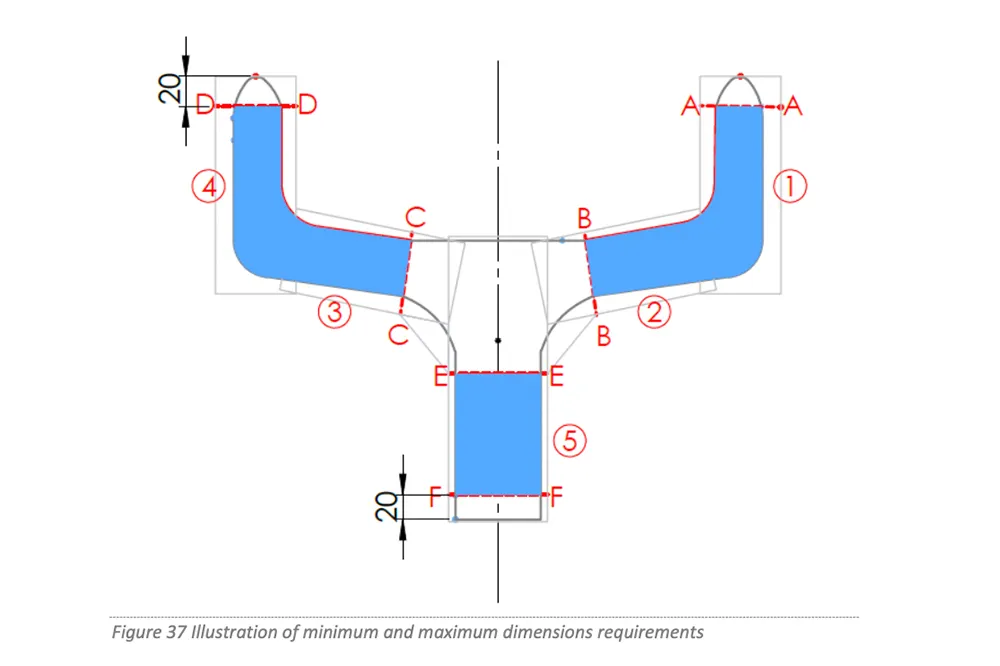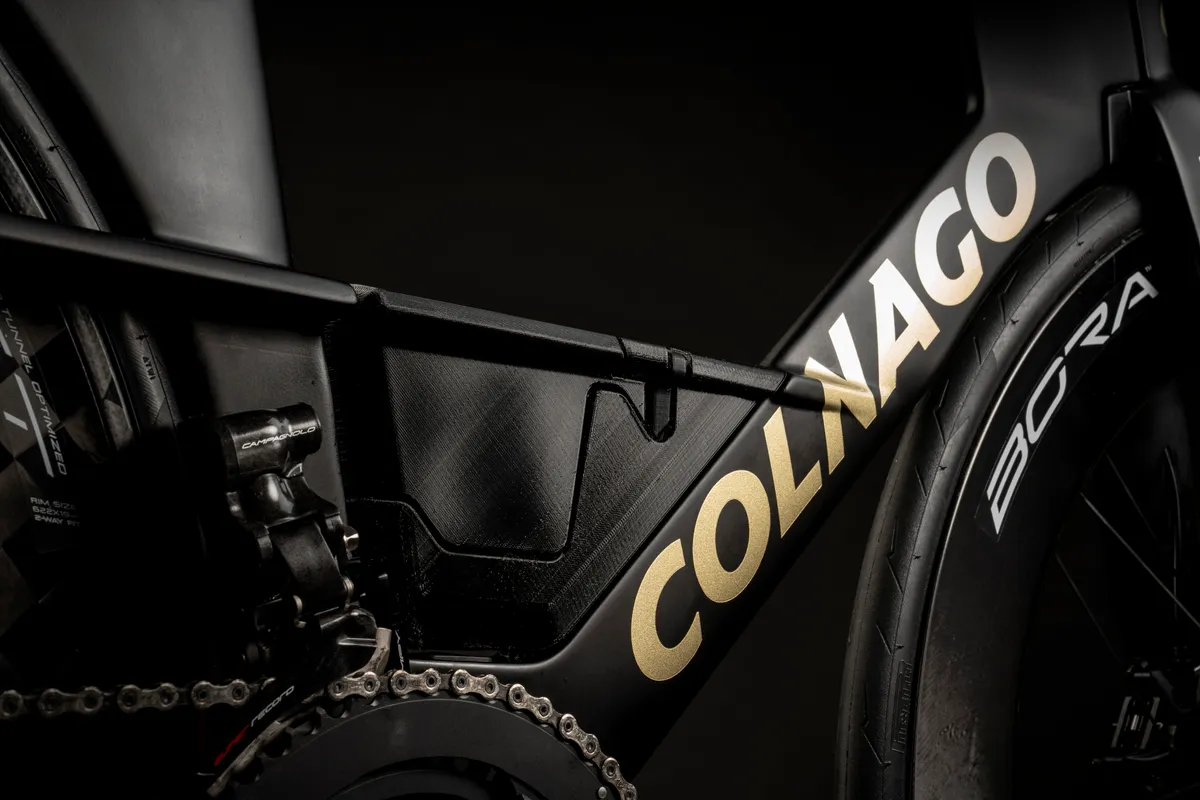With the 2022 season coming to a close, the Union Cycliste International (or UCI for short – the sport’s global governing body) has its beady eyes fixed firmly on updating the sport’s technical regulations for the following year.
Yes, that’s right, a new version of the (snappily named) Clarification guide of the UCI technical regulations has been published, and will come into effect on 1 January 2023.
As you’d expect, it’s full of opaque and complicated rules; some new, many old.
Crowd favourites such as the 6.8kg minimum bike weight and maximum sock height rules are unchanged.
But some of the new rules and updates are likely to have material effects on bikes and equipment designed for use in UCI-sanctioned events, such as those races on the WorldTour calendar.
With that in mind, let’s take a look at six key updates to the regulations. From minimum handlebar width and updated aero regulations, to TT tech and helmet dimensions, here's what’s new for 2023 – and how it might be set to change bike tech.
Super-narrow handlebars are banned on the road

After a few ambitious riders had begun experimenting with extremely narrow handlebars in recent years, the UCI has stepped in to put a stop to the fun – or bring in some much needed safety limits (depending on your perspective).
While there was previously only a maximum permitted overall handlebar width (which still stands at 500mm for road, track and time trial bikes), a minimum overall handlebar width of 350mm has now been implemented for certain events as well.
In both instances, this is measured outside to outside, meaning at the outside edge of the outermost point of each side of the handlebar.
Specifically, the rule now states: “The minimum overall width (outside – outside) of traditional handlebars (road events) and base bars (road and track events) is limited to 350 mm.”

Reading between the lines, this suggests there’s no minimum width for “traditional handlebars” (UCI speak for “drop handlebars”) in non time-trial events on the track (for example, the points race).
This would make sense because elite track riders have been using narrower handlebars than this for many years without major difficulties.
It’s on the road that the use of increasingly narrow handlebars has brought the issue to the UCI’s attention – and it’s a topic that has divided opinion.
Dan Bigham, Taco van der Hoorn and Jan-Willem van Schip have been notable advocates among active riders, for example, but former professional Adam Blythe has repeatedly expressed concerns about their safety for bunch racing.
Van der Hoorn’s bike at the Tour de France, for example, measured just 30cm across between the hoods, though this was with the brake levers aggressively angled in, rather than as the sole result of a narrow handlebar.

Road handlebars can still have an element of flare – a trend we saw at the Tour de France, enabling riders to achieve a narrow body position when riding on the hoods, while retaining additional leverage and control from the drops.
An increasing number of brands – including Trek on the new Madone – now offer a performance-focused road handlebar with flared drops, when previously the design was mostly confined to gravel handlebars.
With that in mind, it will still be possible to have a handlebar that measures 350mm-wide at the drops, but also includes a narrower position at the brake hoods.
AeroCoach (a performance consultancy and manufacturer of specialist cycling kit owned by Dr Xaiver Disley), has recently announced its new "fully UCI legal" Ornix road handlebar, for example, which measures 375mm wide at the drops (centre to centre) but just 325mm wide (again, centre to centre) at the point where the brake levers attach.
Why the limit has been set at 350mm for road handlebars and time trial/track base bars isn't clear. Our best guess would be that the UCI wishes to draw a line in the sand and has simply picked an arbitrary figure.
The 3:1 rule is no more
Previously, the dimensions over various components, such as handlebars, seatposts and time trial aero bars and other accessories, were restrained by the so-called '3:1 rule', with a maximum length of 8cm and a minimum width (or thickness) of 1cm.
This meant the maximum length-to-width ratio of the component could be no greater than three-to-one. If a tube was 2cm wide, for example, it could have a maximum permitted length of 6cm.
This rule was intended to limit the maximum size, and therefore effectiveness, of any aerofoil sections.
The 2023 regulations now state that the minimum and maximum cross-sections of road or track handlebars and stems are simply limited to 10mm and 80mm.

With handlebars and stems (and integrated cockpits, where the two are combined into one part), in particular, each section of the component must fit within a template of boxes defined by a diagram shown in the regulations.
If our interpretation of the new rule is correct, it would now be possible to build a component with a much more streamlined shape.
Whether or not this would actually be faster remains to be seen, of course.
Given bikes and their components interact (aerodynamically) with a rider when in use, simply increasing the aerodynamic efficiency of any single part may not always be the optimal solution for the system as a whole.
Ribble, for example, took a different tact with the Ultra handlebar on its Ultra SLR aero road bike. This innovative handlebar is claimed to reduce the overall drag of the rider and bike by manipulating the airflow over the rider behind it, rather than reducing drag in isolation.

More reach – and even longer stems?
In recent years, some riders – and elite track riders, in particular – have gravitated towards stems of extreme length in an effort to get a more stretched-out and aerodynamic position.
Velobike, for example, produces its Elite Longboi stem in lengths from 150mm out to an outrageous 200mm.
That’s longer than the 190mm we previously thought was the longest bike stem available.
As a result, the UCI has increased the allowed reach for bikes with traditional handlebars by 50mm (time trial aero bar reach is covered by a different set of rules, which we’ll discuss later).
The rule now states, “in no case shall the front of the handlebars exceed the vertical plane passing at horizontal distance of 100 mm from the the axis of the front wheel spindle”.

This amount of reach was previously only allowed in track sprint events, but is now the rule for all events where “traditional handlebars” are used.
Curiously, despite increasing the allowed reach by 100 per cent (previously, your handlebars could only extend 50mm in front of the front wheel outside of track sprint events), the UCI still cites a safety concern to justify limiting reach.
It says essentially that the more forward the handlebar is of the front wheel, the slower the handling is, and that this therefore affects a rider's ability to “react quickly to an obstacle or a wind gust”.
This is generally true, though the concurrent rise in the use of narrow handlebars – which typically speed up handling, and therefore counteract this effect to a degree – can perhaps explain why this trend towards extreme levels of reach hasn’t led to major detrimental effects on bike handling so far.
Updated time trial handlebar regulations

With body position being a key factor in time trials, both on track and road, riders and teams are always looking to push the legal limits of rider positioning and bike setup.
In response, the UCI has made a number of amendments to the regulations for time trial bikes for 2023.
There are far too many changes to list exhaustively, but the major shake-up comes in the form of revised reach and aerobar dimensions for riders of different heights.
- Category one riders (up to 179.9cm tall) can now have up to 800mm of reach (the distance between a vertical line through the bottom bracket and the tip of the aerobar extensions).
- Category two (riders between 180 and 189.9cm tall) can have a maximum of 830mm of reach
- Category three riders (over 190cm tall) can have up to 850mm of reach.

Riders in categories two and three must submit a “rider height attestation application form” to the UCI and inform the commissaires panel at the time of any bike check in order to make use of these exemptions.
The new regulations also allow riders in each height category to have differing amounts of armrest pad-to-shifter height.
Category one riders are permitted to have a maximum difference of 100mm, while category two and three riders can have up to 120mm and 140mm, respectively.
Armrest pads (or "forearm supports" as the UCI now calls them) must also be placed at least 180mm away from the tip of the extensions (previously there was no minimum distance).

As with “traditional handlebars”, the UCI has also implemented templates of boxes (of specified sizes) within which time trial basebars, extensions, armrests and stack height spacers must fit.
Within these boxes, it seems manufacturers are free to shape the components however they like, because the 3:1 rule no longer exists.
These changes will likely enable many riders, especially taller ones, to adopt slightly more aggressive time trial positions, with more reach and a higher hand position than before.
Of course, anyone who’s invested in a set of expensive, non-adjustable time trial handlebars might feel aggrieved their setup is now out of date, but that’s often the way it goes with these things.

Bottle cages comes under scrutiny
The UCI has also added additional text surrounding bottle cage design and placement.
We initially speculated the UCI could be looking to clamp down on designs such as that seen on the Colnago TT1 time trial bike, which included an integrated water bottle and bottle cage that looked suspiciously like an aerodynamic fairing.

However, a closer reading shows this isn’t the case – that design is still legal under the new regulations, as far as we can tell.
Instead, the UCI appears to be tightening the language around bottle cages, likely because there have been a number of more cleanly integrated designs on recently launched bikes.
BMC was one of the first manufacturers to employ such a design, with its Timemachine Road 01 and Teammachine SLR 01 road bikes. But it has since been adopted in similar form by other bikes, such as the latest Giant Propel, and doubtless other brands will have taken notice too.
Perhaps looking to keep things on a short leash, the regulations now state “bottle cages that are integrated must be submitted by a manufacturer to the UCI during the approval procedure for framesets, and in any case before use in competition.”

New helmet dimensions
Also new for 2023 is a series of maximum dimensions for road and track helmets.
The regulations now state a helmet must be no longer than 450mm in length, no wider than 300mm and no higher than 210mm from top to bottom.
Though the UCI doesn’t specify, the comically large helmets adopted by some riders during the opening time trial of this year’s Tour de France, may have prompted it to take action.

It’s unlikely any of those helmets would fall foul of these new restrictions, however.
Moreover, the regulations also include another addition, which says helmets manufactured, on the market, or at production stage prior to 1 January 2023 are not required to comply with these new restrictions.
But this may simply be another case of the UCI proactively trying to keep technological innovations in check, and prevent anyone from taking to the start line with a full-on speed skiing helmet.
